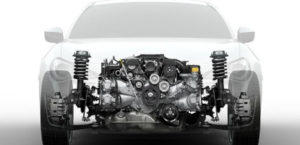Hyundai’s 2.0-liter G4ND engine added to the Nu powertrain family in 2011 and gained ground with the third and fourth generation Optima. The highlight of the motor is the CVVL valve lift system.
In 2011, the Nu range introduced a 2.0-liter unit equipped with a CVVL system that continuously changes valve stroke depending on engine speed. Otherwise, this is a conventional engine with distributed fuel injection, an aluminum block and cast-iron liners, an aluminum 16-valve cylinder head with hydraulic lifters, a timing chain, a phase control system on two shafts, and an intake manifold with variable geometry VIS.
In 2014 they introduced small plastic separators in the engine cooling jacket to slightly increase the movement of antifreeze in the top and most stressed part of the cylinders, and in 2017 they finally added the long-awaited piston cooling oil jets and scuffing problems, if not completely gone, have become much meet less frequently.
The Nu family includes engines: G4NB, G4NA, G4NC, G4ND, G4NE, G4NH, G4NG, G4NL, G4NN.
The engine was installed on:
- Hyundai Elantra 5 (MD) in 2013 – 2015;
- Hyundai i40 1 (VF) in 2011 – 2019;
- Hyundai ix35 1 (LM) in 2013 – 2015;
- Hyundai Sonata 6 (YF) in 2012 – 2014; Sonata 7 (LF) in 2014 – 2019;
- Hyundai Tucson 3 (TL) in 2015 – 2020;
- Kia Carens 4 (RP) in 2013 – 2018;
- Kia Cerato 3 (YD) in 2012 – 2018;
- Kia Optima 3 (TF) in 2012 – 2016; Optima 4 (JF) in 2015 – 2020;
- Kia Sportage 3 (SL) in 2013 – 2016; Sportage 4 (QL) in 2015 – 2020;
- Kia Soul 2 (PS) in 2013 – 2019.
Specifications
| Production years | since 2011 |
| Displacement, cc | 1999 |
| Fuel system | distributed injection |
| Power output, hp | 150 – 172 |
| Torque output, Nm | 195 – 205 |
| Cylinder block | aluminum R4 |
| Block head | aluminum 16v |
| Cylinder bore, mm | 81 |
| Piston stroke, mm | 97 |
| Compression ratio | 10.3 |
| Features | VIS |
| Hydraulic lifters | yes |
| Timing drive | chain |
| Phase regulator | yes |
| Turbocharging | no |
| Recommended engine oil | 5W-20, 5W-30 |
| Engine oil capacity, liter | 4.8 |
| Fuel type | petrol |
| Euro standards | EURO 5/6 |
| Fuel consumption, L/100 km (for Kia Optima 2014) — city — highway — combined |
10.3 6.1 7.6 |
| Engine lifespan, km | ~300 000 |
| Weight, kg | 124 |
Disadvantages of the Hyundai G4ND engine
- The main complaints of the owners of these engines are caused by the appearance of scuffing in the cylinders, which are formed due to the ingress of catalyst crumbs straight into the combustion chamber. In 2017, piston oil cooling nozzles appeared and the problem disappeared.
- Oil consumption is manifested not only due to scoring, but also after the occurrence of piston rings, which are very narrow here and quickly coke. But most often the reason is in the design of the engine: with an open cooling jacket, thin cast-iron liners can easily go elliptical.
- With not very active operation of the machine without sudden acceleration and frequent slipping, the timing chain has a decent resource and can easily go 200 – 300 thousand km without replacement. However, for too hot owners, it often stretches to 150,000 km.
- It cannot be said that the CVVL valve lift system is not very reliable, but it is often ruined by aluminum chips, which appear as a result of scoring and are carried through the lubrication system.
- In specialized forums, they often complain about oil and coolant leaks due to weak gaskets, and the water pump and attachments are also distinguished by a low resource. On the units of the first years of production, there were weak liners and there were cases of their cranking.






